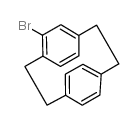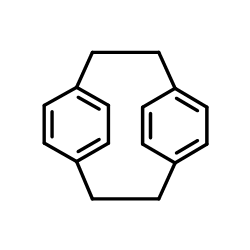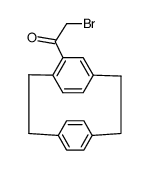1908-61-8
| Name | 4-Bromo[2.2]paracyclophane |
|---|---|
| Synonyms |
2-bromo[2.2]paracyclophane
2-bromo-paracyclophane (+/-)-4-bromo[2.2]paracyclophane rac-4-bromo[2.2]paracyclophane 5-bromotricyclo[8.2.2.2^{4,7}]hexadeca-1(12),4,6,10,13,15-hexaene |
| Density | 1.319g/cm3 |
|---|---|
| Boiling Point | 370.5ºC at 760mmHg |
| Molecular Formula | C16H15Br |
| Molecular Weight | 287.19400 |
| Flash Point | 174.6ºC |
| Exact Mass | 286.03600 |
| LogP | 4.33290 |
| Vapour Pressure | 0mmHg at 25°C |
| Index of Refraction | 1.608 |
|
Section 1: Product Identification Chemical Name:racemic-4-Bromo[2.2]paracyclophane, min. 95% CAS Registry Number:1908-61-8 Formula:C16H15Br EINECS Number:none Chemical Family:organic bromide Synonym:5-Bromotricyclo[8,2,2,24,7]hexadeca-4,6,10,12,13,15-hexaene
Section 2: Composition and Information on Ingredients IngredientCAS NumberPercentACGIH (TWA)OSHA (PEL) Title compound1908-61-8100%no datano data Section 3: Hazards Identification Emergency Overview:Irritating to skin, eyes and respiratory tract. Primary Routes of Exposure:Ingestion, inhalation Eye Contact:Causes slight to mild irritation of the eyes. Skin Contact:Causes slight to mild irritation of the skin. Inhalation:Irritating to the nose, mucous membranes and respiratory tract. Ingestion:No specific information is available on the physiological effects of ingestion. Acute Health Affects:Irritating to skin, eyes and respiratory tract. Chronic Health Affects:No information on long-term chronic effects. NTP:No IARC:No OSHA:No SECTION 4: First Aid Measures Immediately flush the eyes with copious amounts of water for at least 10-15 minutes. A victim may need Eye Exposure: assistance in keeping their eye lids open. Get immediate medical attention. Wash the affected area with water. Remove contaminated clothes if necessary. Seek medical assistance if Skin Exposure: irritation persists. Remove the victim to fresh air. Closely monitor the victim for signs of respiratory problems, such as difficulty Inhalation: in breathing, coughing, wheezing, or pain. In such cases seek immediate medical assistance. Seek medical attention immediately. Keep the victim calm. Give the victim water (only if conscious). Induce Ingestion: vomiting only if directed by medical personnel. SECTION 5: Fire Fighting Measures Flash Point:no data Autoignition Temperature:no data Explosion Limits:no data Extinguishing Medium:carbon dioxide, dry powder or foam If this product is involved in a fire, fire fighters should be equipped with a NIOSH approved positive pressure Special Fire Fighting Procedures: self-contained breathing apparatus and full protective clothing. Hazardous Combustion andIf involved in a fire this material may emit irritating fumes. Decomposion Products: Unusual Fire or Explosion Hazards: No unususal fire or explosion hazards. SECTION 6: Accidental Release Measures Spill and Leak Procedures:Small spills can be mixed with vermiculite or sodium carbonate and swept up. SECTION 7: Handling and Storage Handling and Storage:Store in a tightly sealed container. Keep in a cool, dry, well ventilated place. SECTION 8: Exposure Controls and Personal Protection Eye Protection:Always wear approved safety glasses when handling a chemical substance in the laboratory. Skin Protection:Wear protective clothing and gloves. Ventilation:Handle the material in an efficient fume hood. If ventilation is not available a respirator should be worn. The use of respirators requires a Respirator Respirator: Protection Program to be in compliance with 29 CFR 1910.134. Ventilation:Handle the material in an efficient fume hood. Additional Protection:No additional protection required. SECTION 9: Physical and Chemical Properties Color and Form:white powder Molecular Weight:287.19 Melting Point:no data Boiling Point:no data Vapor Pressure:no data Specific Gravity:no data Odor:not determined Solubility in Water:insoluble SECTION 10: Stability and Reactivity Stability:air and moisture stable Hazardous Polymerization:no hazardous polymerization Conditions to Avoid:none Incompatibility:strong oxidizing agents Decomposition Products:carbon monoxide, carbon dioxide, organic fumes, hydrogen bromide SECTION 11: Toxicological Information RTECS Data:No information available in the RTECS files. Carcinogenic Effects:no data Mutagenic Effects:no data Tetratogenic Effects:no data SECTION 12: Ecological Information Ecological Information:No information available SECTION 13: Disposal Considerations Disposal:Dispose of according to local, state and federal regulations. SECTION 14: Transportation Shipping Name (CFR):Non-hazardous Hazard Class (CFR):NA Additional Hazard Class (CFR):NA Packaging Group (CFR):NA UN ID Number (CFR):NA Shipping Name (IATA):Non-hazardous Hazard Class (IATA):NA Additional Hazard Class (IATA):NA Packaging Group (IATA):NA UN ID Number (IATA):NA SECTION 15: Regulatory Information TSCA:Not listed in the TSCA inventory SARA (Title 313):Title compound not listed Second Ingredient:none SECTION 16 - ADDITIONAL INFORMATION N/A |
| Hazard Codes | Xi |
|---|
|
~99% 
1908-61-8 |
| Literature: Parmar, Rakesh; Coles, Martyn P.; Hitchcock, Peter B.; Rowlands, Gareth J. Synthesis, 2010 , # 24 art. no. P12510SS, p. 4177 - 4187 |
|
~62% 
1908-61-8 |
| Literature: Mamyrbekova, Zh. A.; Bekro, Iv. A.; Soldatova, S. A.; Ageev, E. A.; Guryshev, V. N.; Soldatenkov, A. T. Pharmaceutical Chemistry Journal, 1994 , vol. 28, # 3 p. 203 - 208 Khimiko-Farmatsevticheskii Zhurnal, 1994 , vol. 28, # 3 p. 52 - 56 |

